Disinfection of wells with drinking water. Water disinfection and disinfection, boiling and chemical method of water disinfection in the field
Disinfection, chlorination of water at home (camp) conditions. Disinfection. Reagents, proportions, quantity
How to disinfect water with chlorine in the country, at home or on a hike. Chlorine water with your own hands. How much chlorine do you need? (10+)
How to chlorinate water with your own hands
When using water from natural sources, it must be decontaminated (remove bacteria, viruses and organic substances from it). In our age of antibiotics, foodborne infection is not a sentence, as it was two hundred years ago, but in any case there is nothing pleasant about such an infection.
There are several ways to disinfect:
- Boiling,
- Special filters (disinfectants or reverse osmosis - not passing bacteria, viruses and large organic molecules),
- Ozonation (more about homemade ozonizer),
- Disinfectant tablets
- Chlorination
Advantages and disadvantages of chlorination as a disinfection method
Here we will focus on chlorination (water treatment with chlorine or chlorine compounds). The advantage of chlorination is the preservation of residual chlorine in the water, which prevents its deterioration (flowering, the appearance of unpleasant odors, turbidity) for a rather long time. The main disadvantage is the continuation of the advantage - residual chlorine enters the body, and chlorine is poisonous. However, in the right concentration of residual chlorine is considered safe. In any case, most of us already consume chlorinated water. In addition, it is fairly easy to dechlorinate before drinking.
Chlorination Reagents
For chlorination, I use sodium hypochlorite, or rather, the whitening liquid "Whiteness". Despite the loud name "Bleach", this liquid contains only an aqueous solution of sodium hypochlorite. There is nothing else in it that suits us perfectly. Attention! Whiteness in undiluted form is rather dangerous. When working with her I need to wear glasses and gloves.
According to state standards, for chlorination of water from open ground sources, it is necessary to add a chlorinating agent at the rate of 1-3 mg of active chlorine per 1 liter of water. In 4% White, 20 to 50 g / l of active chlorine. Thus, about 0.075 ml of Whiteness should be added per liter of water. It’s easier to think so. For 20 liters of water you need to add 1.5 ml of White.
In the country
At our cottage, water is supplied through a summer water supply from the lake without any preparation. It is suitable only for watering. For domestic needs (washing dishes, hands, brushing teeth, cooking), I chlorinate it, fill a 200 liter barrel, add 15 ml of White. I do it like that. First, I pour 100 liters into the barrel, then with the help of a measuring cup I add bleach, then I pour another 100 liters. This allows you to mix the resulting mixture well. Further, the water is aged for several hours. After that, the water is ready for use for washing hands and dishes, brushing teeth. Before cooking, I pass this water through a household filter with a carbon cartridge that absorbs chlorine and other harmful compounds.
On a hike
In field conditions, we collect water from a river or lake in a tank. I take a two-liter plastic bottle. I add "White" to the water. You need to add 0.15 ml. This is most conveniently done using an insulin syringe of 100 PIECES / ml. In such a syringe you need to dial 15 units (on a scale not on it). This will be 0.15 ml. If the water has a very unsightly appearance, then you can add a little more, for example, 0.2 ml. Next, the water in the bottle is thoroughly mixed (shaking) and aged for two hours. After that, the water can be filtered to remove residual chlorine and oxidized residues from it by the microorganism and other organic substances. You can filter in a regular household water filter. There are hiking filter options. The composition of the filter element, they do not differ from household, but the form is more suitable for carrying such a filter in a backpack.
Unfortunately, errors are periodically found in articles, they are corrected, articles are supplemented, developed, new ones are prepared. Subscribe to the news to stay informed.
If something is not clear, be sure to ask!
Ask a Question. Discussion article.
More Articles
DIY garden gazebo construction. Build, build self ...
How to build a garden gazebo on your own? ...
Why does potato burn? How to fry potatoes without a stick? Pogora ...
It turns out to fry the potatoes so that it does not burn, but was golden ...
We fix the lining on the screws with our own hands. Advice....
Installing the lining on the support boards ....
How to filter, remove iron. We filter water for a country house ...
How to make a filter for deferrization (filtration) with your own hands? Clean, de ...
We will hang a carpet. Fix, beat ourselves, with our own hands, on our own ...
How to hang a carpet yourself? Reliable, smooth and beautiful. Practical advice ....
Explanatory note - the correct spelling ...
Explanatory letter. Sample. The correct structure, instructions, explanations on ...
Do not eat sausage. Food, nutritional value, benefits, usefulness, harm, tempo ...
Sausage is not worth it. The composition of the sausage includes ingredients that are unnecessary to the body, ...
Own capacity for liquefied gas - gas at home autonomously. Installation Experience ...
A review of the experience of autonomous gasification, installation of a gas tank for liquefied gas. T ...
0 Members and 1 Guest are viewing this topic.
Under the disinfection of drinking water is understood measures to destroy the bacteria and viruses in the water that cause infectious diseases. According to the method of exposure to microorganisms, water disinfection methods are divided into chemical or reagent; physical, or reagent-free, and combined. In the first case, the proper effect is achieved by adding biologically active chemical compounds to the water; non-reagent disinfection methods involve the treatment of water by physical influences, and combined use both chemical and physical effects.
The chemical methods of disinfecting drinking water include its treatment with oxidizing agents: chlorine, ozone, etc., as well as heavy metal ions. Physical ones - disinfection with ultraviolet rays, ultrasound, etc. Before disinfection, water is usually cleaned by filtration and (or) coagulation, in which suspended solids, helminth eggs and a significant part of microorganisms are removed.
The method of ozonation of water is technically complicated and most expensive. The technological process includes successive stages of air purification, its cooling and drying, ozone synthesis, mixing of the ozone-air mixture with the treated water, removal and destruction of the residual ozone-air mixture, and its discharge into the atmosphere. All this also requires additional auxiliary equipment (ozonizers, compressors, air dehumidifiers, refrigeration units, etc.), voluminous construction and installation works.
Ozone is toxic. The maximum permissible content of this gas in the air of industrial premises is 0.1 g / m 3. In addition, there is a danger of an ozone-air mixture explosion.
It should be noted that although a number of foreign companies offer autonomous ozonation plants for organizing the water supply of a separate cottage or for treating pool water, in addition to the very high cost of such devices, it is necessary to ensure their high-quality service. Application of the installation offered by one of the domestic companies for autonomous water supply Without any control systems for ozone in air and water, it can sadly end for its owners. Under these conditions, it is possible to use dosing of hypochlorite in water obtained in a small-sized electrolyzer of the Sanator type, although qualified service is also required here.
The use of heavy metals (copper, silver, etc.) for the disinfection of drinking water is based on the use of their "oligodynamic" properties - the ability to have a bactericidal effect in low concentrations. These metals can be introduced in the form of salt solutions or by electrochemical dissolution. In both of these cases, indirect control of their content in water is possible. It should be noted that the MPCs of silver and copper ions in drinking water are quite stringent, and the requirements for water discharged into fishery reservoirs are even higher.
Chemical methods for the disinfection of drinking water also include the widely used in the early 20th century. o disinfection with bromine and iodine compounds, which have more pronounced bactericidal properties than chlorine, but require more sophisticated technology. In modern practice, it is proposed to use special ion exchangers saturated with iodine to disinfect drinking water with iodization. When water passes through them, iodine is gradually washed out of the ion exchanger, providing the necessary dose in water. This solution is acceptable for small-sized individual installations. A significant drawback is the change in iodine concentration during operation and the lack of constant monitoring of its concentration.
The use of active carbons and cation exchangers saturated with silver, for example, C-100 Ag or C-150 Ag of the Purolite company, does not pursue the “silvering” of water, but the prevention of the development of microorganisms when the movement of water stops. At stops, ideal conditions are created for their reproduction - a large amount of organics trapped on the surface of the particles, their huge area and elevated temperature. The presence of silver in the structure of these particles sharply reduces the likelihood of seeding of the loading layer. Silver-containing cation exchangers developed by NIIPM - KU-23SM and KU-23SP - contain a significantly larger amount of silver and are intended for disinfecting water in low-capacity plants.
Of physical disinfection methodsdrinking water the most common disinfection of water ultraviolet raysbactericidal properties of which are due to the effect on cell metabolism and especially on the enzyme systems of the bacterial cell. Ultraviolet rays destroy not only vegetative, but also spore forms of bacteria, and do not alter the organoleptic properties of water. It is important to note that since no toxic products are formed during UV irradiation, there is no upper dose threshold. By increasing the dose of UV radiation, it is almost always possible to achieve the desired level of disinfection.
The main disadvantage of this method is the complete absence of aftereffect.
The organization of the UV disinfection process requires a larger capital investment than chlorination, but less than ozonation. Lower operating costs make UV disinfection and chlorination economically comparable. Electricity consumption is negligible, and the cost of annual replacement of lamps is not more than 10% of the installation price. UV systems are the most attractive for individual water supply.
A factor that reduces the efficiency of UV-disinfection units during long-term operation is the contamination of quartz lamp covers with deposits of organic and mineral composition. Large plants are equipped with an automatic cleaning system that flushes through circulation through the installation of water with the addition of food acids. In other cases, mechanical cleaning is used.
Ultrasound disinfection of drinking water based on its ability to cause the so-called. cavitation - the formation of voids that create a large pressure difference, which leads to rupture of the cell membrane and the death of a bacterial cell. The bactericidal effect of ultrasound of different frequencies is very significant and depends on the intensity of sound vibrations.
Of the physical methods of individual water disinfection, the most common and reliable is boiling, in which, in addition to destroying bacteria, viruses, bacteriophages, antibiotics, and other biological objects often contained in open sources, the gases dissolved in the water are removed and the water hardness decreases. The taste qualities of water during boiling change little.
In many cases, the most effective complex application of reagent and non-reagent methods of water disinfection. The combination of UV disinfection followed by chlorination in small doses provides both the highest degree of purification and the absence of secondary biocontamination of water. Thus, by treating the pool water with UV irradiation in combination with chlorination, not only a high degree of disinfection is achieved, a threshold concentration of chlorine in the water is reduced, but also, as a result, significant savings on chlorine consumption and an improvement in the situation in the pool itself.
The use of ozonation is similarly distributed, in which the microflora and part of organic pollutants are destroyed, followed by gentle chlorination, which ensures the absence of secondary bio-pollution of water. In this case, the formation of toxic organochlorine substances is sharply reduced.
Since all microorganisms are characterized by certain sizes, by passing water through a filtering partition with pore sizes smaller than microorganisms, water can be completely purified from them. So, filter elements having a pore size of less than 1 micron, according to the applicable
TI 10-5031536-73-10 for non-alcoholic products are considered as providing, i.e. sterilizing. Although at the same time only bacteria are removed from the water, but not viruses. For more “subtle” processes, when the presence of any microorganisms, for example, in microelectronics, is unacceptable, filters with pores no larger than 0.1-0.2 microns are used.
Quite new methods of disinfecting water are electrochemical and electro-pulse. The “Emerald”, “Sapphire”, “Aquamin” installations, etc. are mass-produced. Their work is based on passing water through an electrochemical diaphragm reactor, which is divided by an ultrafiltration cermet membrane into the cathode and anode region. When direct current is supplied in the cathode and anode chambers, alkaline and acidic solutions are formed, and electrolytic formation of active chlorine occurs. In these environments, almost all microorganisms die and partial destruction of organic pollutants occurs. The design of the flow-through electrochemical cell is well-established, and a set of various capacities of the set receive the desired performance. In addition, they are used to obtain disinfectant solutions - catholyte and anolyte, used in medical practice. As for the statements of developers about changing the structure of water and its miraculous properties, let us leave this without comment.
When an electric pulse is applied, an electric discharge in water is produced - electro-hydraulic shock, the so-called effect of L. A. Yutkin. During the discharge, an ultrahigh pressure shock wave occurs, light radiation and ozone is formed. These factors are detrimental to biological objects in the water.
Before quenching thirst with water from stagnant or low-flowing bodies of water (see "Safe" and "dangerous" water), it should be disinfected (disinfected), and then cleaned by filtration from insoluble particles and impurities (sand, clay), and decay products of microorganisms, ions used for disinfection.
However, if it is planned to disinfect water by boiling, then the sequence of the process changes - first filtering, and then disinfection. “Correct” water is colorless, has neither taste nor smell. Turbid water is a suspension of solid particles of various compositions.
The content in water is harmful to human health:
Large amounts of manganese
- Iron as a whole does not have a harmful effect, but the taste and smell of glandular water are unpleasant both in its raw form and after boiling.
- Heavy metals (cadmium, copper, arsenic, mercury, lead) in small doses are harmless, but they accumulate in the body, practically are not removed from it and at high concentrations greatly undermine health. True, usually heavy metals are not found in surface waters. Unless, of course, do not take water from the effluents of a mining and processing or chemical plant.
- Calcium with magnesium is not harmful to humans. Their only drawback is that when boiling, scale forms from their salts, which worsens the appearance of the dishes.
- Sodium with potassium in high concentration gives the water a salty or bitter taste, depending on what prevails in the water along with them, chlorides, sulfates or fluorides. But such water is already closer to sea water, and it must be desalinated.
- Really dangerous is the content in the water of nitrogen compounds, which are the product of a change or vital activity of living organisms. Their source can be, for example, rotting algae, fertilizers or sewage discharged into the river.
- Bacteria are in any water and contrary to popular belief, not all of their species die from boiling. Therefore, in order not to get sick with dysentery or something worse, it is highly advisable to filter and disinfect with combined methods. The most dangerous are bacteria of the group of Escherichia coli, called coliform bacteria. If they are present in water, then the disease can not be avoided.
Water purification methods.
# Filtering
The simplest filter is an empty tin can or a plastic bottle with two to three small holes punched in the bottom (cork) and filled with fine sand for two-thirds; a piece of cloth is preliminarily laid on the bottom of the can or neck of the bottle. Water is poured from above and, passing through the thickness of the sand, flows into the holes. For greater reliability, the filtering process is best repeated many times. If the water is very polluted, the sand should be periodically changed to cleaner.
And if you fill a jar or a plastic bottle with coal, broken into small pieces, taken from a burned-out fire, you will get a more technologically advanced carbon filter. Pure coal is obtained if the wood is burned in a container over high heat. Firewood should be hardwood, as conifers give the filtered water a specific taste and smell.

If there is no "utensil" at hand, then as a filter case you can use a cap or a hat, a shirt sleeve, a trouser-leg or a folded cloth panel, for example, hanging them on a tree branch. So that the filtered water does not leak through the fabric, it should be poured into a recess made in the center of the filter with a narrow stream.
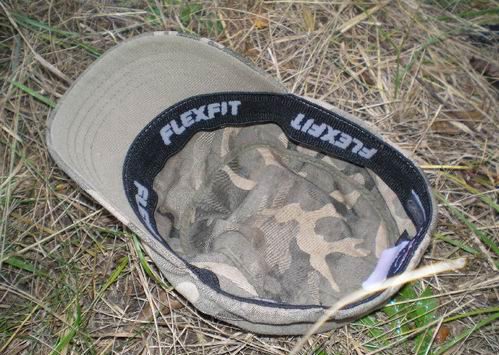
A more sophisticated filter can be made from any available fabric and branches 1.5-2 cm thick. For this, the branches are mounted with a tripod on which pieces of fabric are tied.

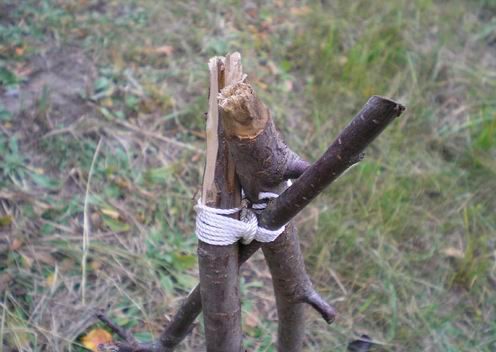

Each such improvised filter is loaded with its own filler. For example, grass, sand, charcoal taken from a burned-out bonfire, composed of deciduous trees.
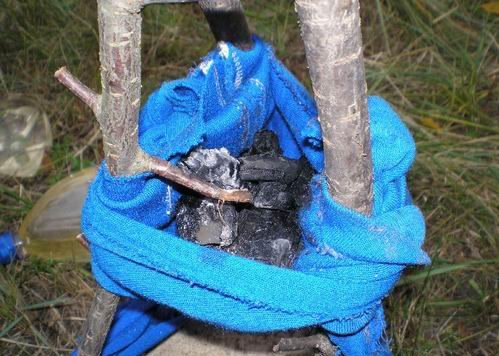
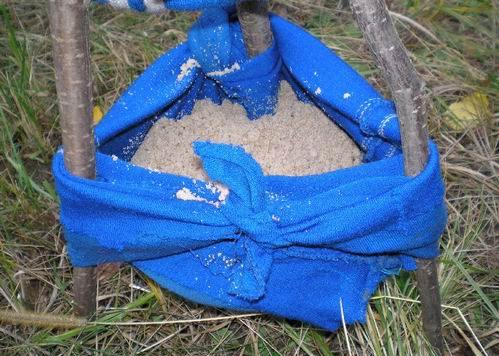

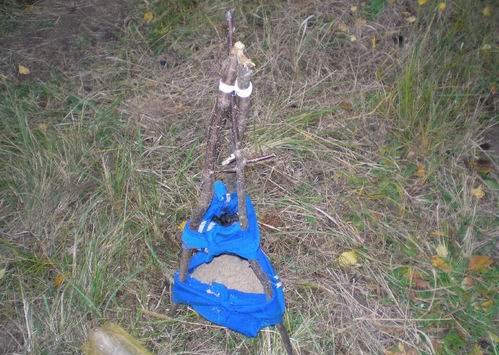
Water should be poured into the filter in the center and in small portions, freely flowing through all layers, the water is filtered and clarified. For example, in the photos below, dirty water taken from an open source and filtered using the filter shown above.
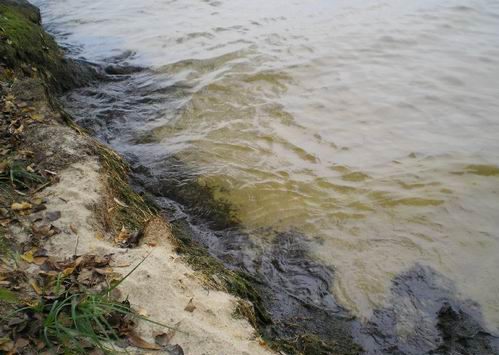
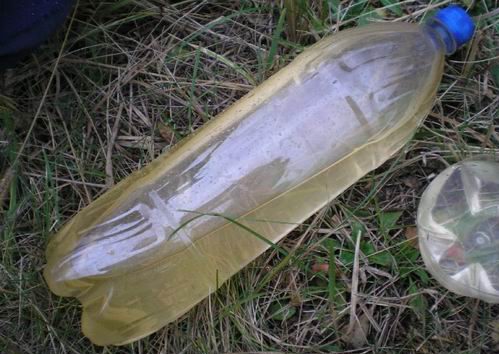
In the photos in the left column, water - before filtering, in the right - after filtering. Differences are clearly visible even with the naked eye.
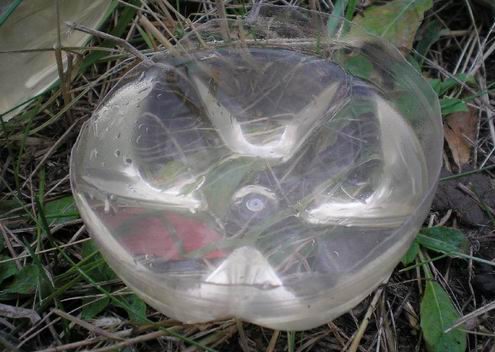
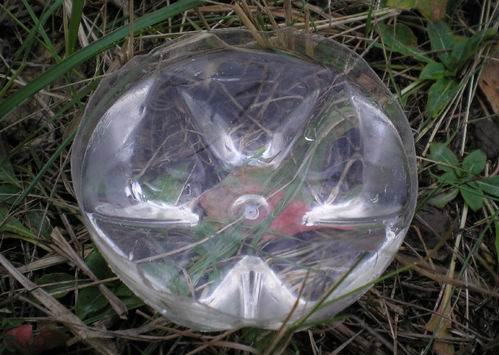
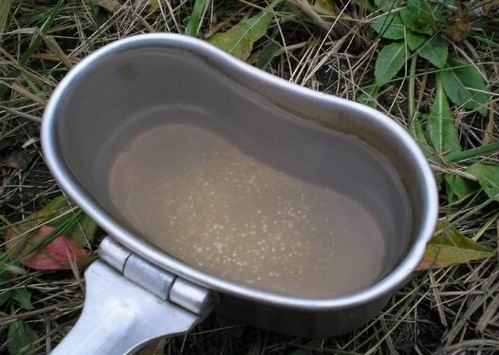
A simpler fabric filter can be made. For example, dig a hole in the ground, put a container in it, make a grating-flooring on top of tree branches, on which to lay a layer of fabric. In the center, it is desirable to push the fabric so that a guide funnel is formed for draining the liquid into the container.
After that, heat a thick layer of sand on the fabric, cover the sand with the next piece of fabric, pour charcoal on top, cover with fabric again and sand again. There can be several such layers - the more, the better. For more reliable disinfection, filtered water is preferably passed through the filter again. And it’s better not through already used, but through done again.
And finally, the simplest (but this does not mean the worst) filter is the “ground pump”. Nothing is needed for its construction - no fabric, no coal. It is enough to have a pond with a suspicious kind of water and a trench tool - a shovel, knife or just a pointed stick. With this tool, 50-100 cm from the reservoir, you need to dig a deep, not less than half a meter, hole and wait until it is filled with water. Then carefully scoop out the water, wait for the pit to fill up again, and scoop out again. And so on until the water becomes clean and transparent.
And if you dream up, you can come up with a dozen other ways to purify water in emergency conditions. For example, to make an elementary filter of adsorption action from a funnel, a piece of cotton wool or gauze and tablets of activated carbon (or birch charcoal) available in the medicine cabinet. And you can make the simplest small-sized and wearable filter in advance, at home.
A plastic cigar case is used as the body of this filter. A hole is made in the bottom of the case. The case is filled (from bottom to top) - a layer of cotton wool 2 cm, a layer of crushed activated carbon 8 cm and again a layer of cotton 2 cm. On top of all these layers are pressed by a plate of permeable porous plastic, like that used in industrial water filters.
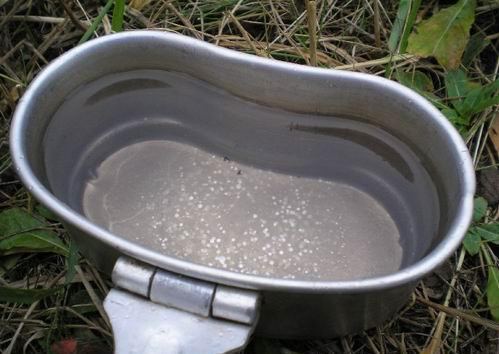
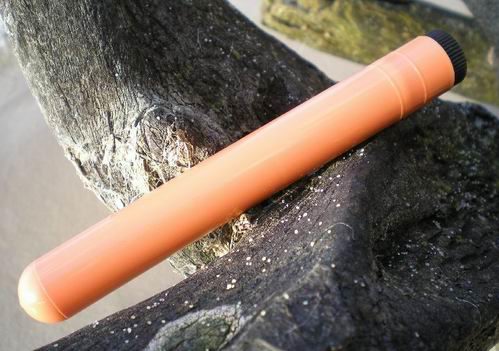

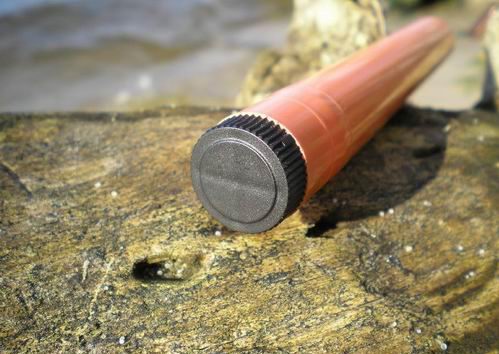
Activated carbon has a large number of microscopic pores and, due to this, absorbs (absorbs and absorbs) organic molecules from water and some inorganic substances. It is especially effective for filtering organics, which gives the water a yellowish color, smell, etc. and to remove heavy metals from water.
The procedure for using such a makeshift filter is very simple. We lower the upper end of the case into the water and then through the small hole in the bottom we suck it into ourselves.
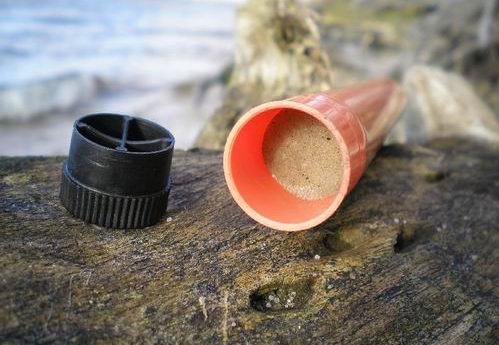
For reference, one tablet of activated carbon is able to filter about 0.9-1 l of water with a cleaning efficiency of up to 85-90%, then the productivity drops sharply and the tablet needs to be changed. Thus, it is quite possible to calculate the total resource of such a filter. Pay attention to the following, the old carbon filter does not begin to clean, but pollutes the water - filtered water becomes worse than the original one. This is due to the fact that the previously accumulated dirt begins to be washed out of the sorbent.
1. Insert the reed into the bottom sand and suck in the water that is filtered through the bottom sediments.
2. Wrap a reed or tube with a cloth and lowering it a little deeper than the surface of the water, absorb moisture.
Regardless of the filtration method used, it is imperative to boil water after this for 10 minutes. Then let it stand for at least 30 minutes and carefully drain clean water without agitating the sediment.
# Distillation and distillation of water.
The simplest steam desalination plant can be made from any metal pipe bent at a right angle - by a knee. The pipe is installed upside down on two non-combustible supports, for example two sand rollers. Inside the pipe, water is poured. At the bend, a fire is made. Metal pans or cans are put on the ends of the pipe, laid out from the inside with a cloth. Steam from boiling water is deposited on the cool metal of the pots, absorbed by the cloth and drips dropwise into the set containers.
A simpler steam desalination plant can be made from a piece of plastic film, a container and several poles. To do this, install the poles with a tripod, hang a container on them and wrap the top with plastic wrap. At the same time, in the upper part of the "bag" you should leave a hole for extracting smoke, and lower the ends to inward by 10-15 cm and lightly lift up to form peculiar pockets-indentations.
Now if you make a fire under the container and bring the water to a boil, the steam will condense on the film and drain down into the pockets formed by the folded edges of the polyethylene. This desalination plant is quite capricious in work, since a strong fire strives to melt the film, and a weak one does not maintain boiling at the required level. This disadvantage can be avoided if a bonfire is built inside the hearth laid out of stones, on which to set the container.
The stones will cover the fusible film from excessive heat and direct it up to the bottom of the tank. And of course, it is better to use thin firewood of deciduous trees giving less sparks as firewood. In the most extreme case, you can cover a container with boiling salt or contaminated water with one or more layers of fabric or even clothing, and when it is saturated with steam, remove the device with a twig or other hand protecting your body from burns and squeeze it. In this case, it is very important that drops of boiling water do not reach the fabric, for which purpose water should be poured into the container by no more than a third.
Dip the tube into the neck of a water-filled and closed vessel that is set on fire. Fix the other end of the tube in a clogged receiving tank, which should be located inside another vessel filled with cold water to cool the steam passing through the tube. You can use any tubes. To prevent water vapor from escaping into the atmosphere, seal joints with mud or wet sand.
A simpler method is a variant of a desert distiller. Remove the tube from a closed vessel in which contaminated or salt water should boil. Place the other end of the tube under the solar distiller. A piece of tin, tree bark or a folded down leaf of the plant will cover the vessel and will direct the steam into the tube.
In the winter season, salt water is desalinated by freezing. To do this, the flask is filled with water and, allowing it to freeze by 2/3, the residue (brine) is drained. If the formed ice retains a salty taste, it must be melted and frozen again by 2/3. Usually repeated freezing leads to success.
Methods for disinfecting water.
# Boiling
The most reliable way to sanitize water is to boil it for at least 8 to 10 minutes. If the liquid is taken from a suspicious or highly contaminated source (which is allowed only in extreme cases), it should boil over low heat for half an hour.
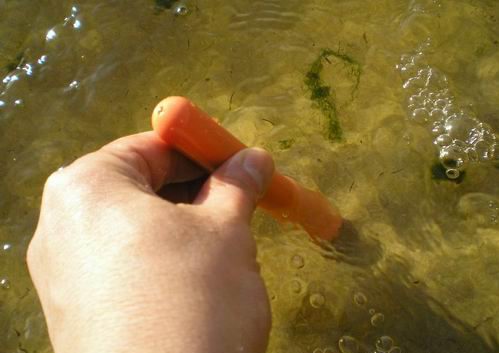
For a greater disinfecting effect (depending on the area) in water during boiling, you can add:
Young branches of spruce, pine, fir, cedar, juniper - 100-200 g per bucket. A brown, insoluble precipitate settled at the bottom cannot be drunk.
- Willow bark, willow, oak, beech, young birch bark - 100 -150 g per bucket of water and boil for 20-40 minutes or insist in warm water for 6 hours.
- 2-3 handfuls of well washed reindeer moss.
- Lichen (stone moss), hazel or walnut bark - 50 g per 10 liters of water.
- Arnica or calendula herb - 150-200 g per bucket, boil for 10-20 minutes or insist for at least 6 hours.
- Grass of feather grass, tumbleweed, yarrow or field violet at the rate of 200-300 g per bucket of water.
- Camel thorn or saxaul.
- Eliminate the unpleasant odor of water by adding to it when boiling charcoal from a fire and subsequent sedimentation.
# Chemical
It is most reliable to use industry-specific tablets for water disinfection, such as pantocide, aquacept, aquababs, clorcept, hydrochloronazone and others. One tablet of such a preparation usually disinfects 0.5-0.75 L of water 15 to 20 minutes after dissolution.
If the water is very contaminated, the dose must be doubled. In this case, the turbidity settles to the bottom, the water brightens. The quality of tablets for water disinfection can be assessed as follows: if the tablet contains 3-4 mg of active chlorine, then the quality is excellent, 2-3 mg is good, 1-2 mg is satisfactory, less than 1 mg is bad, it makes no sense to use it.
To some extent, they can be replaced by:
Potassium permanganate, but you need to know how much to add to the water, otherwise you can kill the entire intestinal microflora. Enough about 1 - 2 g per bucket of water, or per liter of water, several crystals are slightly smaller than a match head, while the color of the solution should be slightly pink. This amount is quite enough to kill extraneous microflora (especially Escherichia coli and deserterium bacillus and silver staphillococcus).
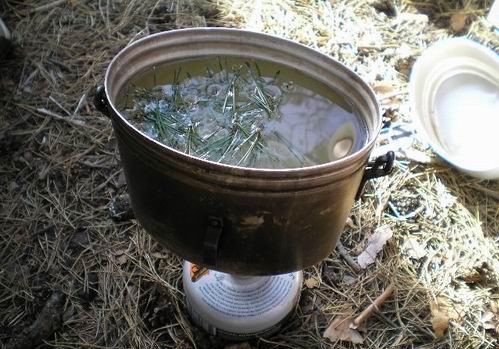
Iodine at the rate of 3-4 drops of 5% tincture per 1 liter of water, mix well and let stand for an hour. There are also a number of drugs (iodine tablets) used for individual disinfection of water. According to experts, potassium permanganate and iodine are the most effective means for disinfecting small volumes of water in the field.
- Aluminum alum - a pinch on a bucket of water.
- In extreme cases, even ordinary table salt will help - one tablespoon in 1.5 - 2 liters of water.
In all cases, water should be allowed to stand for 15-30 minutes.
Various industrial filters are a good means for disinfecting water: “Barrier”, “Brita”, etc. It is most convenient to have a pocket version of the Rodnik filter, which has the form of a plastic tube, one end of which is lowered into a reservoir, and sucked through the other by mouth. Water disinfection in such a filter is carried out using powerful iodine-containing reagents.
Katadyn handheld filters are also well-suited for field use, allowing you to drink water from any source without fear for your health. According to manufacturers, bacteria, germs and viruses are destroyed during the filtration process, and some models also improve the taste of water.
# "Natural"
In the field, you can use the leaves of chamomile, celandine, lingonberry, raspberry or St. John's wort, and other medicinal antiseptic plants, the bactericidal properties of which are recognized by medicine. Celandine - a leader among medicinal plants with antibacterial action, kills almost all pathogenic microorganisms known to science, since this plant synthesizes iodine-containing compounds, its caustic juice - a bright yellow-orange color. In addition, you can use the bactericidal properties of fungi, such as raincoat, porcini fungus, chaga, etc.
Mineral silicon is a powerful activator of water and has significant bactericidal properties. Water does not deteriorate, is stored for a long time, and is purified. Silicon water is prepared very simply, you need to lower the silicon into a container with raw or boiled water and store it there all the time. The amount of silicon at the rate of 1-3 g per 1 liter. Writing stand a day.
A good disinfectant is silver. Therefore, all silver jewelry that has appeared on the people of the accident should be removed and allowed for its intended purpose. To increase the area of \u200b\u200bjewelry can be flattened, breaking between the stones. But we should not forget that silver is a heavy metal that has a high degree of health hazard (along with lead, cobalt, arsenic and other substances).
Like other heavy metals, silver can accumulate in the body and cause diseases (argyrosis - silver poisoning). In addition, for the bactericidal action of silver on bacteria, sufficiently high concentrations are required, and in acceptable quantities (about 50 μg / L) it can only have a bacteriostatic effect, i.e. stop the growth of bacteria without killing them. And some types of bacteria are generally practically not sensitive to silver. All these properties somewhat limit the use of silver. It may be appropriate only in order to preserve the source of clean water for long-term storage.
Creation of water reserves and water consumption.
The creation of water reserves is advisable if during the transitions the water sources are located at a great distance from each other. In a hot tropical climate during storage, water quickly changes its taste, blooms, and therefore it is advisable to boil it before use. For storage and transportation of water, various types of canisters are used, made of metal that is not amenable to oxidation, or of plastics. Before refueling, in order to ensure the safety of water for a long time, the container is disinfected, and then, thoroughly rinsing, pour boiled water.
For long-term storage of water, metal silver is sometimes used. The antimicrobial effect of silver is 1750 times stronger than the action of carbolic acid, 3.5 times - mercuric chloride. It is believed that the antimicrobial effect of silver is even higher than that of many antibiotics, not to mention the fact that silver easily copes with antibiotic-resistant strains of bacteria.
In the heat, after a long transition, you should not drink cold water immediately and a lot. It is necessary to cool for several minutes, then rinse your mouth with cool water and only then drink. If this rule is neglected, then you can easily and very badly catch a cold. It is also not recommended to attack the water, trying to drink as much as possible in one gulp. Sometimes it’s enough to wait 10-15 minutes to drink much less water after them.
Drink should be in small sips, slowly, taking 3 -5-minute breaks. It is especially important to adhere to this rule when you have to carry water on yourself. If for some time you did without water, then having found it, do not pounce on it with greed. First, sip the water in small sips, as a large amount of water entering the dehydrated body causes vomiting, which leads to an even greater loss of precious moisture.
The main measures for water supply and water consumption in extreme conditions:
1. The search for water, especially in desert conditions, should be one of the highest priority measures;
2. If there is a water source, drink water without restrictions, and in a hot climate, slightly more than is required to satisfy thirst;
3. With limited water supplies, establish, based on the circumstances, a rigid daily norm of water, reduce as much as possible the amount of food consumed, especially thirsty;
4. Purification and disinfection of water extracted from stagnant and low-flowing water bodies;
5. The device of shelters from direct solar radiation and the definition of such a mode of activity that would ensure minimal thermal load.
To minimize moisture loss by the body, the following measures should be taken:
Always drink water in small sips, holding it in your mouth in debt.
- Do not overwork, rest more, do not smoke.
- Do not lie on warm earth and hot stones.
- Do not drink alcohol, alcohol takes fluid from vital organs and binds it to other substances.
- Do not talk, breathe with your nose, not your mouth.
Partially used materials from books:
"Man in extreme environmental conditions." V.G. Volovich
"Great Encyclopedia of Survival in Extreme Situations." A. Ilyichev.
Water, as a source of life on earth, requires thorough purification before use. The modern environmental situation does not guarantee the purity of water, even if you use natural sources. For effective cleansing, there are some means for disinfecting water. As individual means intended for water purification, special tablets, devices are used.
Water purification tablets
For tablets, a number of requirements are presented, upon the fulfillment of which water becomes acceptable for consumption. Pills must certainly be completely safe for human health. They must have high antibacterial properties. Also, tablets intended for water purification, must necessarily be easily dissolved. The time allotted for the complete dissolution of this safety tool should not exceed 10 minutes. Water purification tablets should not impair the organoleptic properties of the liquid. The formation of absolutely any precipitate is completely unacceptable. You should pay attention to the expiration date of the antibacterial tablets used.
Water disinfectants in tablets mainly contain chlorine compounds, but iodine tablets exist, it is also a rather effective means of water purification. But they have one big drawback, which is the effect of these tablets on the organoleptic properties of water. In extreme conditions, you can disinfect water by applying 10% tincture of iodine - approximately two drops of iodine are required per liter of water. After about 30 minutes, you can already drink even contaminated water.
Water Purification Filters
For home water disinfection, there are a large number of special filters designed to purify water. Ion-exchange filters act on water with an antiseptic aquacept. The most serious drawback of such filters is their excessively low efficiency. Only the first initial 15 liters are practically cleaned, as expected, and subsequently the quality of cleaning is constantly reduced.
Ozonation
A rather good result is ozonation - a means for disinfecting water, which is widespread in developed countries. The bactericidal property of ozone is associated with its penetration directly through cell membranes, followed by the oxidation of organic substances, which leads to the death of pathogenic bacteria. Ozonation of water is a high-tech method of processing, this method allows not only to effectively purify the water, but also significantly improve its taste, destroy extraneous odors.
Silver water disinfection
Silver disinfection of water is also possible. This process is associated with the process of combining silver ions with bacterial enzyme systems. But it should be remembered that silver is a heavy metal that has the ability to accumulate in the human body, causing argyrosis - a disease caused by silver poisoning. Also, exposure to silver for some kind of bacteria is absolutely useless. Silver is mainly used to preserve already disinfected water. Quite often, silver filters based on activated carbon are used.
Ultra-violet rays
A means for disinfecting water that does not require sophisticated equipment, which is quite easy to use in a domestic environment, is disinfection of water with ultraviolet rays. A certain wavelength of ultraviolet radiation is detrimental to the enzyme systems of bacteria, causing their death. Mercury lamps made of quartz sand are used as a source of applied radiation.
Ultrasonic treatment
Ultrasonic treatment can be used to purify water. This effect is called ultrasonic cavitation. Oscillations of the surrounding aquatic environment are subject to an extremely high frequency; under such influence, the bacterial environment is mechanically destroyed. A similar method is used in medicine for the effective disinfection of medical instruments.



